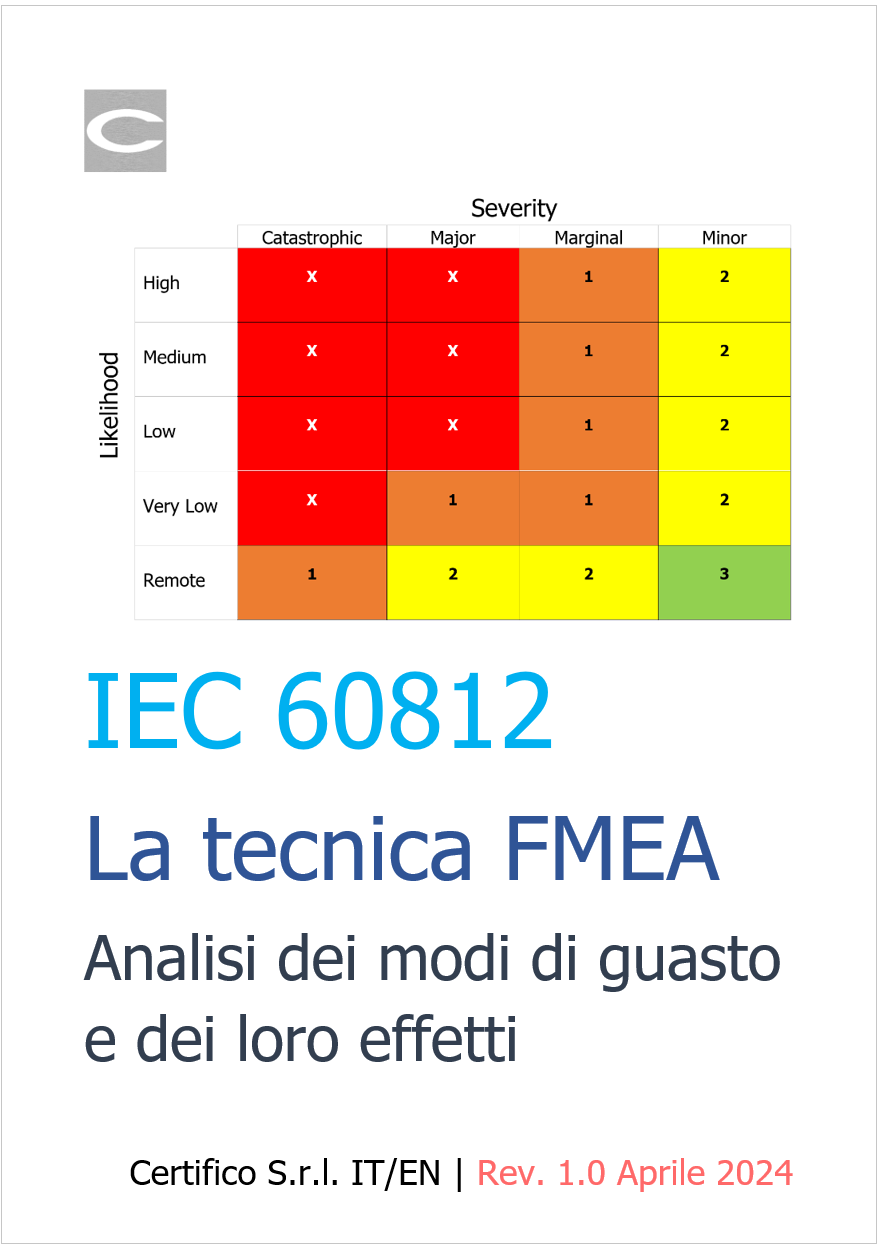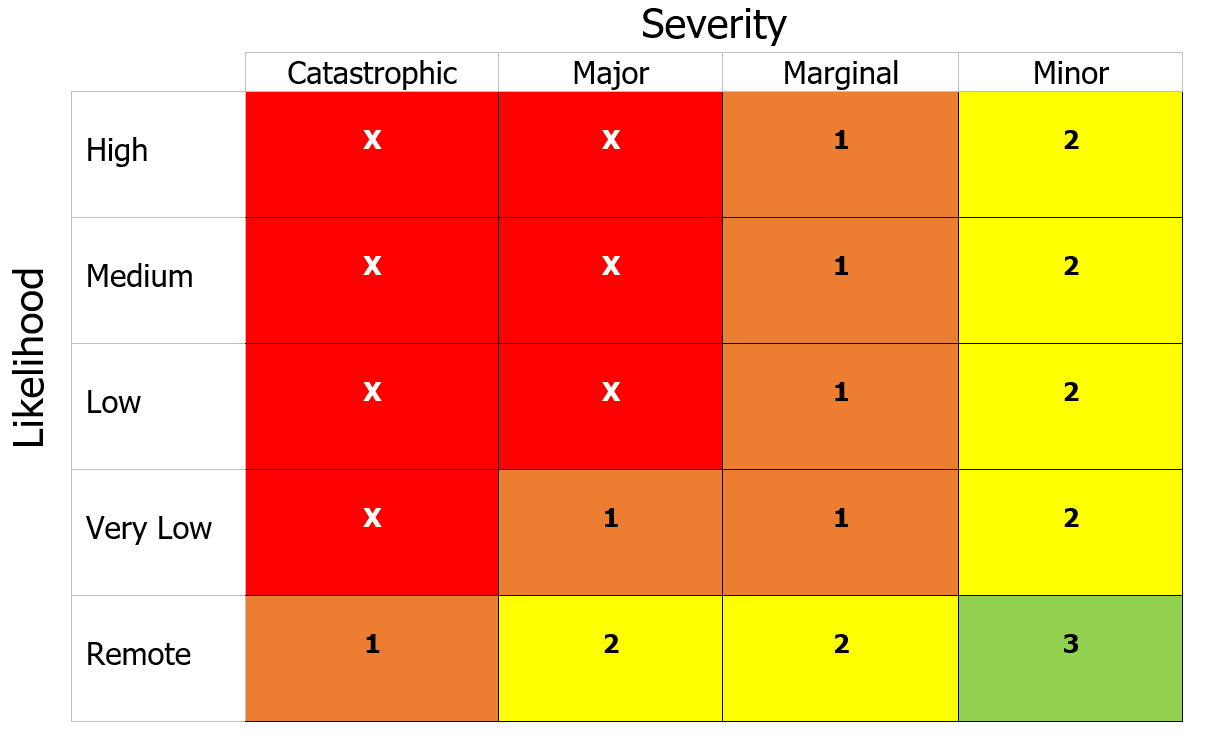IEC 60812: la tecnica FMEA
| ID 3082 | | Visite: 31338 | Documenti Riservati Normazione | Permalink: https://www.certifico.com/id/3082 |
IEC 60812: la tecnica FMEA - Analisi dei modi di guasto e dei loro effetti / Update 2024: IEC 60182:2018
ID 3082 | Update Rev. 1.0 del 26.04.2024 / Documento completo in allegato
Un Documento illustrativo dell'FMEA estratto dalla norma IEC 60812 che norma il metodo.
Il metodo FMEA è specificato nella norma IEC 60812 "Tecniche di analisi per l’affidabilità dei sistemi - Procedura per l’analisi dei modi di guasto e dei loro effetti (FMEA)".
FMEA (Failure Mode Effects Analysis) di derivazione aereonautica, automotive e medicale consente di approcciare l’analisi dei rischi di un prodotto o di un processo (nuovo o modificato) correlandola a indici relativi e specificando contromisure che riducono progressivamente l’indice globale di rischio dell’intero progetto di un prodotto o di un processo produttivo. La tecnica si applica a qualsiasi settore merceologico, incluso quello dei servizi.
- IEC 60812:2018 Analisi dei modi e degli effetti di guasto (FMEA e FMECA)
La Norma in oggetto sostituisce completamente la Norma IEC 60812:2006
FMEA/FMECA
Con l'FMEA viene effettuata un’analisi di tipo qualitativo dei singoli componenti di un sistema per determinarne: i “failure mode” (inconvenienti) e gli “effects” (effetti) sul sistema.
FMECA, Failure Mode and Effect Criticality Analisys (“Analisi critica dei modi di guasto/errore e dei loro effetti”) aggiunge un percorso di valutazione orientato all’assunzione di decisioni operative coerenti.
La FMEA è un’analisi di tipo qualitativo, la FMECA aggiunge valenze quantitative. Nell’uso, ormai, quando si parla di FMEA si intende la FMECA.
Data pubblicazione: 2018-12
Inizio validità: 2019-01
Questa Norma descrive come può essere pianificata, eseguita, documentata e manutenuta l'analisi dei modi e degli effetti di guasto (FMEA), inclusa anche la sua Variante relativa all’analisi dei modi e degli effetti di guasto e della loro criticità (FMECA).
La finalità della FMEA è quella di stabilire in quale modo i componenti oppure i sistemi possano cessare di svolgere le funzioni per le quali sono stati progettati e quindi individuare eventuali interventi correttivi o di mitigazione.
Questa edizione costituisce revisione tecnica della precedente.
La Norma in oggetto sostituisce completamente la Norma CEI EN 60812:2006-10, che rimane applicabile fino al 14.09.2021.
Processo
Analisi qualitativa
Per prima cosa è descritto il corretto svolgimento delle attività necessarie a realizzare il servizio o il corretto funzionamento del bene. In riferimento a ciò vengono elencati:
- tutti i possibili modi di errore/guasto,
- i loro effetti,
- le cause potenziali.
L’analisi qualitativa (FMEA propriamente detta) termina a questo punto, a seguire si valutano le criticità (analisi quantitativa).
Analisi quantitativa
I tre elementi analizzati sono presi in considerazione associandovi un giudizio di valore su criteri predefiniti, che permetterà di calcolare un indice di priorità del rischio (IPR).
Vengono considerate:
- la probabilità che si verifichi la causa del modo di errore/guasto (e quindi del guasto);
- la gravità degli effetti dell’errore/guasto;
- la rilevabilità dell’errore/guasto.
[...]
Estratto IEC 60812:2018
B.1 General
Criticality methods provide a means of prioritizing failure modes. The methods described in Annex B are only those which combine measures for the parameters: likelihood of failure, the consequences of failure, and (in the case of the risk priority number) the detectability of the failure.
NOTE Use of a single parameter to rank importance is not classed as a criticality analysis.
There are a variety of ways these parameters might be combined to produce a criticality Annex B describes four methods: the criticality matrix, the criticality plot, the risk priority number and the alternative risk priority number.
The types of consequence considered, the scales that are to be used for each of theparameters and the method of combination to give a criticality should be decided during the planning stage. The methods described are general and should be tailored for the applicationin order to be meaningful in relation to the context and objectives of the analysis.
B.2 Measurement scales for criticality parameters
B.2.1 General
Criticality parameters can be measured qualitatively, quantitatively or semi-quantitatively.
. Criticality parameters might be expressed qualitatively using descriptive categories, ordered by degree. For example, 'minor', 'major' or 'catastrophic' (for severity of effect); or 'frequent', 'occasional' or 'remote' (for the likelihood of the failure mode occurring).
- Criticality parameters might be expressed quantitatively using empirical or other data in the form of a failure rate or probability of failure, and quantifiable consequences such as the economic or financial cost of failure Ratio scales are established to match the relevant range of data with specified units.
- When the data only allows descriptive or order of magnitude estimates to be made, then criticality parameters might be expressed using ordinal rating scales, sometimes called ranking scales If numerical labels are associated with ordinal ranks of likelihood and severity, or bands of failure rates and financial cost ranges, the approach is sometimes referred to as semi-quantitative.
The points on the measurement scale are expressed according to the application For qualitative, quantitative and semi-quantitative approaches, the points correspond to the descriptive categories, the numerical estimates and the ranks/bandings respectively.
When developing the scales for measuring criticality parameters, care should be taken to use the best available information to help avoid biased results A useful classification system might already exist in the organization and should be considered for application.
B.2.2 Scale definition
The range of the scales should span from the most severe to the most benign consequence of interest, from the highest to lowest likelihood, and from the highest to the lowest degree of detectability that can be associated with the failure modes under consideration for the scenario of interest.
The points on the measurement scales adopted should have a clear and precise definiti on that is meaningful in the context of the analysis to facilitate consistent and accurate assessment The definitions should align with available data and be expressed in terms that are meaningful to those carrying out the analysis.
Logarithmic scales might be more appropriate than linear scales for quantitative data for both consequences and likelihood Points on the scales used for qualitative and semi-quantitative approaches should be defined accordingly.
EXAMPLE The cost of a catastrophic failure is expected to be several orders of magnitude, rather than several times higher, than the cost of a minor failure.
The choice of categories (or bands) for qualitative and semi-quantitative scales should be based on consideration of the meaningfulness for the chosen parameters. There should be asufficient number of categories to enable the complete range of effects to be classified and adequately separated Generally, at least three categories are required in order to provide sufficient differentiation across the complete range considered. A large number of categories might be inappropriate because it can lead to excessive effort being required to identify the correct category when subsequent treatment does not significantly differ between categories.
NOTE As a guide, between three and ten categories are commonly used.
The selection of the category descriptions and the meanings of each should be carefully considered taking into account the manner in which they are to be used Care should be exercized in the selection of verbal descriptions or number/letter labels for a qualitative approach as these can in themselves influence the choices made during the analysis Each of the scales should be supported by a table defining the meaning of the words used.
B.2.3 Assessing likelihood
The likelihood value can be expressed quantitatively, semi-quantitatively or qualitatively.
In a quantitative approach using ratio scales, the likelihood values might be obtained for the specific failure modes, or they might be derived from generic data sources or estimated using data related to operation of similar items in comparable environments and applications.
Generally, where quantitative data are available, they tend to relate to the failure of an item or process as a whole rather than of that of each particular failure mode of that element An estimate of the likelihood of a failure mode might be obtained by apportioning the likelihood of failure of the item as a whole into likelihoods of its potential failure modes In addition, an adjustment might be made to represent the likelihood that the failure mode will result in a particular consequence (normally a defined severity).
NOTE
If the likelihood is expressed as a failure rate then, unless otherwise stated, t his approach implicitly assumes a constant failure rate and hence can be inappropriate in some circumstances In addition, while the failure rate of an item might be obtained from specific data, the relative probability of its failure modes and the probability that a particular level of effect will follow a given failure mode are often also obtained from a different set of data sources or are based on judgement.
Where likelihood bands/categories are used, the descriptions might make use of applicable empirical data, expert judgement of the design team or other appropriate sources It is essential that the scale is consistently applied so that the relative frequency of failure modes is accurately assessed and is compatible with available data.
In order to facilitate accurate and consistent application, the following should be taken into account.
a) If quantitative measures such as probabilities or frequencies are used, the units should be clearly stated.
EXAMPLE 1 If a percentage value is used, then what the percentage refers to is stated, such as, the percentageof items that fail in a year.
b) A numerical explanation of the category description that is relevant for the range of likelihoods expected for the given application should be included, if possible, to aid common understanding.
EXAMPLE 2 With highly reliable hardware systems, a “frequent” categorization for a failure mode of an element might be equivalent to one failure in several years whereas for less reliable systems, a "frequent" failure mode of an element might occur several times a year.
The likelihood descriptor for rare failures should be realistic when applied to the worst case consequence.
B.3 Assigning criticality using a matrix or plot.
B.3.1 General
The relationship between criticality parameters may be represented in many ways to enable identification of the criticality rank The likelihood and consequences of failure might be expressed on continuous scales, or in categories, then combined to be visually represented in the form of a plot, or matrix, respectively This criticality plot or matrix is then utilized to set priorities for treatments.
The meaning of each criticality rank, and the link to treatments that are associated with them, should be discussed and agreed with the stakeholders prior to analysis as part of the FMEA planning. This gives a clear and unambiguous understanding of how failure modes should be handled and the potential business impact of such decisions Failure to do this negates the value of the criticality analysis and can add significant time and cost through superfluous activities or inadequate treatment of failures The number of criticality ranks required will be determined by the organization’s requirements and the analysis application.
B.3.2 Criticality matrix
A criticality matrix analysis produces a measure of importance by combining values for likelihood and consequence A criticality matrix might also be known as a risk matrix The values for each of the parameters are formed into a matrix and a criticality rank is allocated to each of the cells within the matrix The criticality rank can be associated with the level of treatment which should be applied to manage the associated failure mode(s) For low rank failure modes such treatments may include “no action”.
Figure B.1 shows an example of a qualitative criticality matrix.
Figure B.1 - Example of a qualitative criticality matrix
NOTE 1 An example of a four level criticality categorization (as used in Figure B.1) would be:
Category X: "Unacceptable”;
Category 1: “Undesirable";
Category 2: "Acceptable";
Category 3: "Minor”.
In some cases a failure mode can result in a range of different consequences, depending on circumstances Where this is the case, the consequence to which the likelihood applies should be specified It can be useful in this case to consider the criticality for several of the possible consequences.
In the example matrix in Figure B.1 the risk represented by each criticality category increases from the lower right of the matrix to the upper left However, the treatments taken for each failure mode will depend only upon the criticality classification (i.e. the colour or number of the criticality code) and not the cell of the matrix.
NOTE 2 Even though terms such as "acceptable" can be used, this does not imply that further treatment might not be desirable.
Figure B.1 is only an example of the structure of a matrix and should not be regarded as the definitive form The actual form will depend on the particular application If the number of likelihood bands and/or severity of consequence categories differs then the size of the matrix will differ from the one shown in Figure B.1. Equally, the criticality associated with consequence-likelihood combinations might differ in which case the colour coding pattern will also differ.
A matrix need not be limited to two dimensions, it can be extended to add a third parameter or, theoretically, as many other parameters as required However, the complexity and effort needed to formulate a valid and manageable multi-dimensional grid can be considerable and not cost effective as every combination of parameters requires assessment.
The criticality matrix should be calibrated to ensure that failure modes with similar importance have the same criticality value, so that they receive the same treatment In addition, where severity or likelihood categories are based on quantitative, or semi-quantitative assessments, consideration should be given to the acceptability of different treatments being applied to failure modes which have numerical values either side of a criticality boundary.
[...]
Certifico Srl - IT/EN | Rev. 1.0 2024
©Elaborazione copia/stampa autorizzata Abbonati su PDF allegato
Matrice Revisioni
| Rev. | Data | Oggetto | Autore |
| 1.0 | 26.04.2024 | IEC 60812: 2018 Analysis techniques for system reliability - Procedure for failure mode and effects analysis (FMEA) | Certifico Srl |
| 0.0 | 2016 | --- | Certifico Srl |
Collegati
| Descrizione | Livello | Dimensione | Downloads | |
|---|---|---|---|---|
| IEC 60812 la tecnica FMEA - Analisi dei modi di guasto e dei loro effetti Rev. 1.0 2024.pdf Certifico Srl - Rev. 1.0 2024 |
1254 kB | 90 | ||
| Preview CEI EN IEC 60812 2018.pdf |
1638 kB | 6 | ||
| Focus IEC 60812 FMEA .pdf Certifico Srl - Rev. 0.0 2016 |
503 kB | 385 |










































